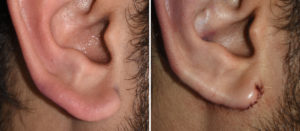Background: The earlobe is an important component of the aesthetics of the ear. While occupying the smaller non-cartilaginous portion of the ear, it has a variety of semi-circular shapes as well as different attachments to the side of the face. While there are no accepted aesthetic standards for many of these earlobe features, the one feature that does stand out, or ideally should not stand out, is its size.
The size of the earlobe is its most obvious feature at any distance. The earlobe becomes more noticeable when its vertical length occupies one-third or more of the total ear height. While this is most commonly recognized to occur with aging (the earlobe stretches but does not biologically grow), it can also occur naturally as part of its development. This can be seen at a young age where, while the ear will continue to grow up through puberty, its component proportions do not usually change.
Reduction of the large earlobe has been done by a variety of techniques, all of which work well if expertly done. What differentiates them is the pattern of skin excision, the dimensions that it changes and the location and appearance of the resultant earlobe scar.
Case Study: This young male was having multiple facial procedures done including a setback otoplasty. He also felt that his earlobes stuck out too far and were overall too big.

When performing an inferior helical rim excision technique for earlobe reductions it is important to know whether the earlobe is attached or not to the side of the face…and whether the patient wants to maintain that type of attachment to change it. This changes the line of the excision as it approaches the anterior portion of the earlobe.
Highlights:
1)The size of the earlobes should be less than one-third of the total vertical ear length.
2) The ideal earlobe reduction technique does not place a visible scar on the outer skin surface of the earlobe.
3) The interior helical rim earlobe reduction technique is the most verstile with special attention paid to its attachment to the face.
Dr. Barry Eppley
Indianapolis, Indiana



